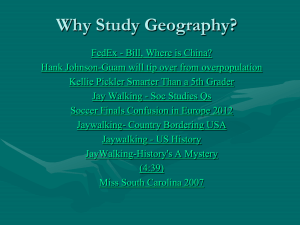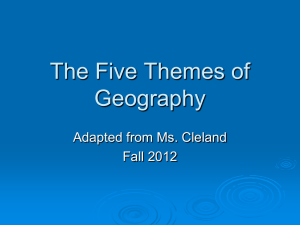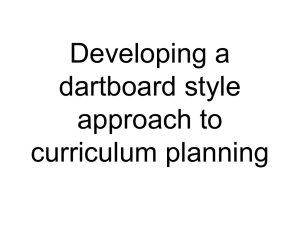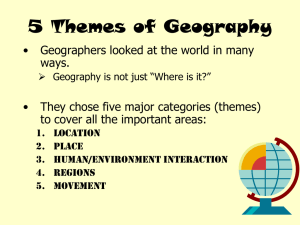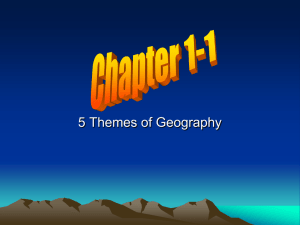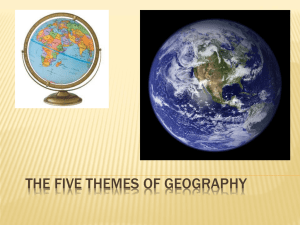2015 Pre AP World Geography summer reading(1)
advertisement
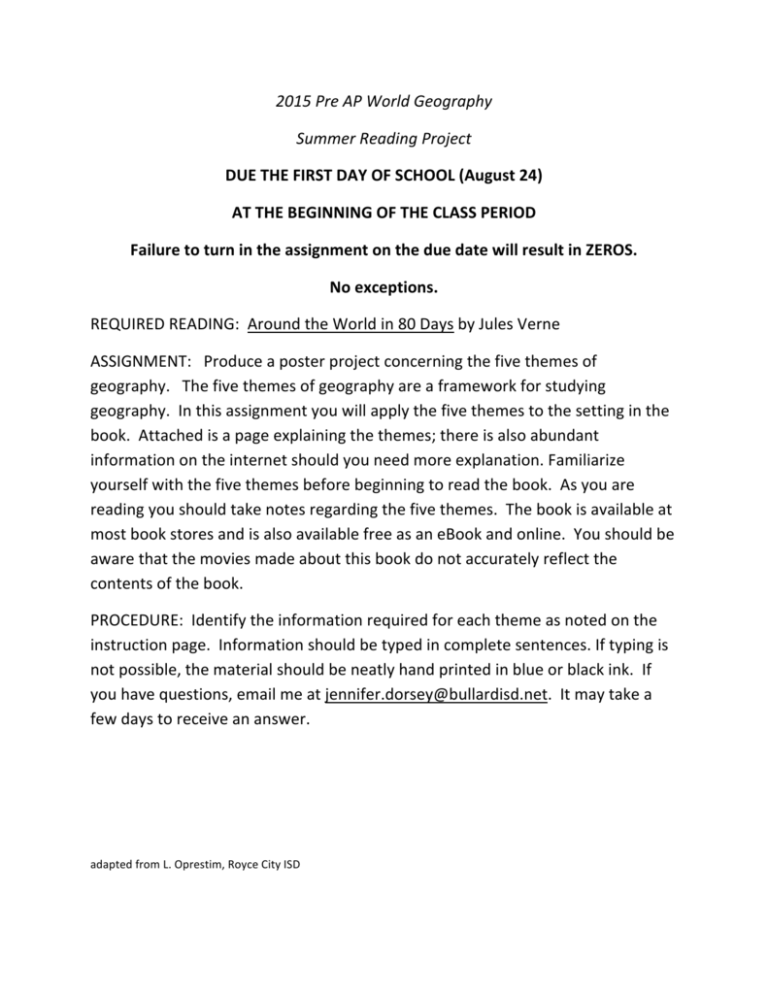
2015 Pre AP World Geography Summer Reading Project DUE THE FIRST DAY OF SCHOOL (August 24) AT THE BEGINNING OF THE CLASS PERIOD Failure to turn in the assignment on the due date will result in ZEROS. No exceptions. REQUIRED READING: Around the World in 80 Days by Jules Verne ASSIGNMENT: Produce a poster project concerning the five themes of geography. The five themes of geography are a framework for studying geography. In this assignment you will apply the five themes to the setting in the book. Attached is a page explaining the themes; there is also abundant information on the internet should you need more explanation. Familiarize yourself with the five themes before beginning to read the book. As you are reading you should take notes regarding the five themes. The book is available at most book stores and is also available free as an eBook and online. You should be aware that the movies made about this book do not accurately reflect the contents of the book. PROCEDURE: Identify the information required for each theme as noted on the instruction page. Information should be typed in complete sentences. If typing is not possible, the material should be neatly hand printed in blue or black ink. If you have questions, email me at jennifer.dorsey@bullardisd.net. It may take a few days to receive an answer. adapted from L. Oprestim, Royce City ISD THE PROJECT Materials needed: standard size white poster board; map (colored) pencils Complete the following information as you read the book, then create the poster using the information gathered from your reading. STEP 1 -­‐ General Map On one side of the poster board sketch an outline map of the continents. Draw in and label the following items: the seven continents, the Pacific, Indian, Arctic, Atlantic, and Southern Oceans; the equator, Tropic of Cancer, Tropic of Capricorn, Arctic Circle, Antarctic Circle, Prime Meridian • Title the map; draw and label a compass • Create a key with one symbol for each of the five themes of geography. STEP 2 - Adding the five themes information to the map • Location: o Locate and label four locations found in the book. Draw your location symbol at each location. o Absolute location: Next to two of the chosen locations, provide the absolute location. o Relative location: Next to the other two locations, write a brief description of their respective locations. • Place: o Locate and label ONE place that represents the theme of place on your map. Draw your symbol next to it. • Region o Locate and label four regions on your map. Draw your symbol next to each. o Categorize each as functional, perceptual, or formal and provide a brief explanation of why it belongs to that category. • Movement o Locate and label four places/regions on the map that represent examples of movement. Draw your symbol next to each. o Draw the method of transportation used next to each. • Human Environment Interaction (HEI) o Locate and label two places/regions that represent examples of HEI. Draw your symbol next to each. STEP 3 - Drawing and Explaining Place -USE ONE HALF OF THE BACK OF THE POSTER • • Use the same location used for the theme of PLACE on your map. Draw a picture representing the place that you labeled as you envision it in the book. The picture should be colored. • Categorize the parts of the picture as being either physical or human characteristics. • Write 2-3 sentences summarizing your drawing and how it relates to the theme of place. • • STEP 4 - Human-Environment Interaction (HEI) - USE THE OTHER HALF OF THE BACK OF THE POSTER • Use the HEI examples already identified on the map. • Provide two quotes from the book for each of the two examples • For one example, explain how the physical environment affects the characters. • For the second example, explain how the characters affect the environment. THE FIVE THEMES OF WORLD GEOGRAPHY The FIVE THEMES OF GEOGRAPHY make up the basic tools of a geographer and define the location, place, region, human-environment interaction, and movement for a community (which can be a handful of people or a large megalopolis). 1. LOCATION (absolute and relative): Where is it? Absolute location pinpoints an exact location on the earth while relative location describes a location in terms of what is nearby: a. The absolute location of Austin, Texas is 30°27′N latitude, 97° 74′W longitude. b. The relative location describes Austin as the 4th largest city in Texas, positioned along the Colorado River, north of San Antonio on Interstate 35. 2. PLACE: What is it like? Place describes a location. Is the story, in this case, set in hills, mountains, by a lake or an ocean? Is there running water, inside plumbing, technology? Are the streets paved and maintained? What modes of transportation are being used? Place is made up of both physical and human characteristics of a locale. a. Physical characteristics: include bodies of water, landforms, vegetation, climate, weather, etc. b. Human characteristics: include buildings, technology, clothing, roads, languages, etc. 3. REGION: How are places similar and different? Regions help categorize the world for deeper understanding. Regions may be formal, functional, or perceptual. a. Formal: Formal regions can be defined by measures of population, per capita income, ethnic background, crop production, population density and distribution, or industrial production, or by mapping physical characteristics such as temperature, rainfall, growing season, and average date of first and last frost. This type of region has one or more unifying characteristics. b. Functional: Functional regions are organized around a place or focal point with the surrounding areas by transportation systems, communication systems, or other economic association involving such activities as manufacturing and retail trading. They usually involve interaction of some form. For example, the Bureau of Census defines a typical functional region as a metropolitan area, and the Austin-Round Rock Metropolitan Area makes up a functional region. c. Perceptual: Perceptual regions are based on ideas and experiences rather than geographic markers. The states found in the Mid-West vary and may include Nebraska, Indiana, and Ohio depending on a person’s perspective. Also, the South or Dixie is a perceptual region when deciding if Maryland or Texas belongs in the South. 4. HUMAN-ENVIRONMENT INTERACTION: How do people relate to the physical world? This theme explores how people relate to, use, build up or modify their environment. For example: a. How do the people of Nepal farm the Himalayas? b. Why do some people use a forest as a park while others use it for paper? c. How do the Inuit of Alaska stay warm in igloos? 5. MOVEMENT: How do people, goods, and ideas move from one location to another? Movement asks how goods, services, and information are moved within a culture and between cultures. a. Are there telephones, televisions, or do the people just tell a Mom to communicate? b. Is there a pony express to move the mail? Is there Internet? c. How do the people trade food, clothing, etc.?
